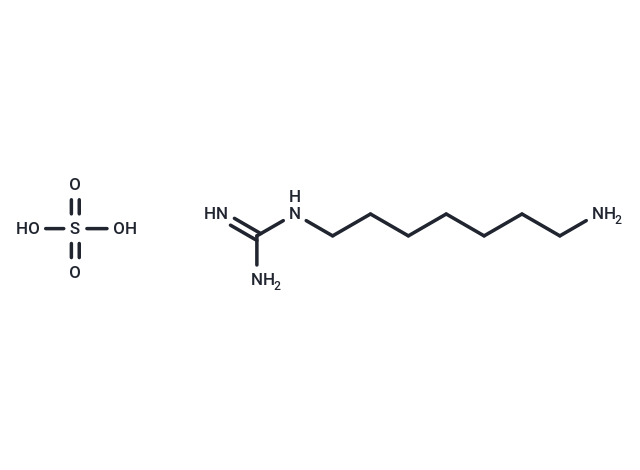Shopping Cart
Remove All Your shopping cart is currently empty
Your shopping cart is currently empty
GC7 Sulfate is a potent inhibitor of deoxyhypusine synthase (DHS). Eukaryotic translation initiation factor 5A2 (eIF5A2) is the only known substrate for DHS, so GC7 inhibits the activation of eIF5A2 by inhibiting DHS activity.

| Pack Size | Price | USA Warehouse | Global Warehouse | Quantity |
|---|---|---|---|---|
| 5 mg | $47 | In Stock | In Stock | |
| 10 mg | $89 | In Stock | In Stock | |
| 25 mg | $197 | In Stock | In Stock | |
| 50 mg | $297 | In Stock | In Stock | |
| 100 mg | $478 | In Stock | In Stock | |
| 500 mg | $1,050 | - | In Stock |
| Description | GC7 Sulfate is a potent inhibitor of deoxyhypusine synthase (DHS). Eukaryotic translation initiation factor 5A2 (eIF5A2) is the only known substrate for DHS, so GC7 inhibits the activation of eIF5A2 by inhibiting DHS activity. |
| Targets&IC50 | S1P1:10 nM(ki) |
| In vitro | Cell cycle analysis show that GC7 Sulfate reduces the CHO-K1 cell population in the G1-phase of the cell cycle by 42% and increases the number of cells in the S-phase by 44%. Furthermore, GC7 Sulfate inhibited the growth of H9 cells in a concentration-dependent manner. While 1 μM GC7 Sulfate had no significant effect on H9 cell proliferation, inhibition of growth became evident with 3 μM GC7 Sulfate. At 10 μM GC7 Sulfate, H9 cell growth was completely blocked within 1 or 2 days after the addition of the drug[1]. |
| Molecular Weight | 270.35 |
| Formula | C8H22N4O4S |
| Cas No. | 150417-90-6 |
| Smiles | O=S(=O)(O)O.N=C(N)NCCCCCCCN |
| Relative Density. | no data available |
| Storage | Powder: -20°C for 3 years | In solvent: -80°C for 1 year | Shipping with blue ice/Shipping at ambient temperature. | |||||||||||||||||||||||||||||||||||
| Solubility Information | H2O: 90 mg/mL (332.9 mM), Sonication and heating are recommended. DMSO: < 1 mg/mL (insoluble or slightly soluble) | |||||||||||||||||||||||||||||||||||
Solution Preparation Table | ||||||||||||||||||||||||||||||||||||
H2O
| ||||||||||||||||||||||||||||||||||||
| Size | Quantity | Unit Price | Amount | Operation |
|---|

Copyright © 2015-2025 TargetMol Chemicals Inc. All Rights Reserved.